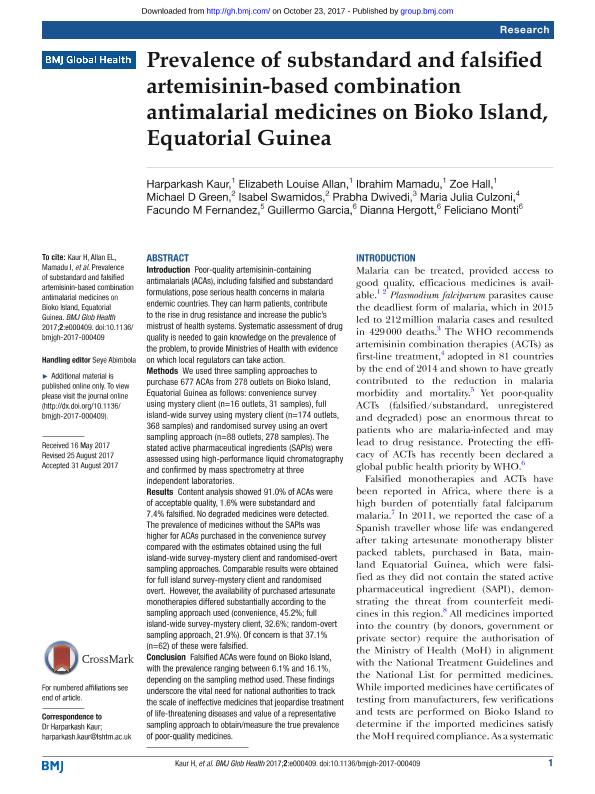Mostrar el registro sencillo del ítem
dc.contributor.author
Kaur, Harparkash
dc.contributor.author
Allan, Elizabeth Louise
dc.contributor.author
Mamadu, Ibrahim
dc.contributor.author
Hall, Zoe
dc.contributor.author
Green, Michael D
dc.contributor.author
Swamidos, Isabel
dc.contributor.author
Dwivedi, Prabha
dc.contributor.author
Culzoni, Maria Julia

dc.contributor.author
Fernandez, Facundo M.
dc.contributor.author
Garcia, Guillermo
dc.contributor.author
Hergott, Dianna
dc.contributor.author
Monti, Feliciano
dc.date.available
2018-09-07T15:04:07Z
dc.date.issued
2017-10
dc.identifier.citation
Kaur, Harparkash; Allan, Elizabeth Louise; Mamadu, Ibrahim; Hall, Zoe; Green, Michael D; et al.; Prevalence of substandard and falsified artemisinin-based combination antimalarial medicines on Bioko Island, Equatorial Guinea; BMJ Publishing Group; BMJ Global Health; 2; 4; 10-2017; 1-12
dc.identifier.issn
2059-7908
dc.identifier.uri
http://hdl.handle.net/11336/58693
dc.description.abstract
Introduction Poor-quality artemisinin-containingantimalarials (ACAs), including falsified and substandardformulations, pose serious health concerns in malariaendemic countries. They can harm patients, contributeto the rise in drug resistance and increase the public?smistrust of health systems. Systematic assessment of drugquality is needed to gain knowledge on the prevalence ofthe problem, to provide Ministries of Health with evidenceon which local regulators can take action.Methods We used three sampling approaches topurchase 677 ACAs from 278 outlets on Bioko Island,Equatorial Guinea as follows: convenience surveyusing mystery client (n=16 outlets, 31 samples), fullisland-wide survey using mystery client (n=174 outlets,368 samples) and randomised survey using an overtsampling approach (n=88 outlets, 278 samples). Thestated active pharmaceutical ingredients (SAPIs) wereassessed using high-performance liquid chromatographyand confirmed by mass spectrometry at threeindependent laboratories.Results Content analysis showed 91.0% of ACAs wereof acceptable quality, 1.6% were substandard and7.4% falsified. No degraded medicines were detected.The prevalence of medicines without the SAPIs washigher for ACAs purchased in the convenience surveycompared with the estimates obtained using the fullisland-wide survey-mystery client and randomised-overtsampling approaches. Comparable results were obtainedfor full island survey-mystery client and randomisedovert. However, the availability of purchased artesunatemonotherapies differed substantially according to thesampling approach used (convenience, 45.2%; fullisland-wide survey-mystery client, 32.6%; random-overtsampling approach, 21.9%). Of concern is that 37.1%(n=62) of these were falsified.Conclusion Falsified ACAs were found on Bioko Island,with the prevalence ranging between 6.1% and 16.1%,depending on the sampling method used. These findingsunderscore the vital need for national authorities to trackthe scale of ineffective medicines that jeopardise treatmentof life-threatening diseases and value of a representativesampling approach to obtain/measure the true prevalenceof poor-quality medicines.
dc.format
application/pdf
dc.language.iso
eng
dc.publisher
BMJ Publishing Group
dc.rights
info:eu-repo/semantics/openAccess
dc.rights.uri
https://creativecommons.org/licenses/by-nc-nd/2.5/ar/
dc.subject
Substandard Medicine
dc.subject
Falsified Medicine
dc.subject
Antimalarials
dc.subject
Artemisinin
dc.subject.classification
Otras Ciencias Químicas

dc.subject.classification
Ciencias Químicas

dc.subject.classification
CIENCIAS NATURALES Y EXACTAS

dc.title
Prevalence of substandard and falsified artemisinin-based combination antimalarial medicines on Bioko Island, Equatorial Guinea
dc.type
info:eu-repo/semantics/article
dc.type
info:ar-repo/semantics/artículo
dc.type
info:eu-repo/semantics/publishedVersion
dc.date.updated
2018-09-06T18:45:29Z
dc.journal.volume
2
dc.journal.number
4
dc.journal.pagination
1-12
dc.journal.pais
Países Bajos

dc.journal.ciudad
Amsterdam
dc.description.fil
Fil: Kaur, Harparkash. London School of Hygiene and Tropical Medicine; Reino Unido
dc.description.fil
Fil: Allan, Elizabeth Louise. London School of Hygiene and Tropical Medicine; Reino Unido
dc.description.fil
Fil: Mamadu, Ibrahim. London School of Hygiene and Tropical Medicine; Reino Unido
dc.description.fil
Fil: Hall, Zoe. London School of Hygiene and Tropical Medicine; Reino Unido
dc.description.fil
Fil: Green, Michael D. US Centers for Disease Control and Prevention; Estados Unidos
dc.description.fil
Fil: Swamidos, Isabel. US Centers for Disease Control and Prevention; Estados Unidos
dc.description.fil
Fil: Dwivedi, Prabha. Centers for Disease Control and Prevention; Estados Unidos
dc.description.fil
Fil: Culzoni, Maria Julia. Consejo Nacional de Investigaciones Científicas y Técnicas; Argentina. Universidad Nacional del Litoral. Facultad de Bioquímica y Ciencias Biológicas; Argentina
dc.description.fil
Fil: Fernandez, Facundo M.. Georgia Institute of Technology; Estados Unidos
dc.description.fil
Fil: Garcia, Guillermo. Bioko Island Malaria Control Project, Medical Care Development International; Guinea Ecuatorial
dc.description.fil
Fil: Hergott, Dianna. Bioko Island Malaria Control Project, Medical Care Development International; Guinea Ecuatorial
dc.description.fil
Fil: Monti, Feliciano. Bioko Island Malaria Control Project, Medical Care Development International; Guinea Ecuatorial
dc.journal.title
BMJ Global Health
dc.relation.alternativeid
info:eu-repo/semantics/altIdentifier/doi/https://dx.doi.org/10.1136/bmjgh-2017-000409
dc.relation.alternativeid
info:eu-repo/semantics/altIdentifier/url/https://gh.bmj.com/content/2/4/e000409
Archivos asociados
